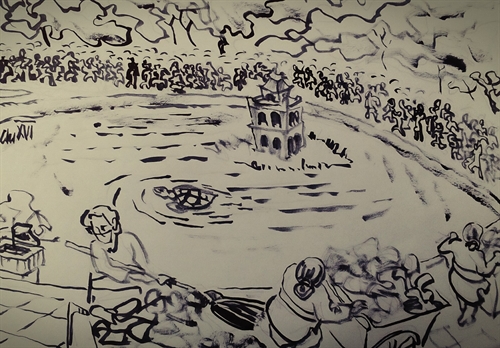 Society
Society

The newly-opened pedestrian areas around Hoàn Kiếm (Sword) Lake, the iconic of Hà Nội, has got big applause from both tourists and locals as it brings more space for those who wish to get an insight into the city.
 |
Children play folk games on the walking streets around Hòan Kiếm Lake.— VNS Photo Đoàn Tùng |
HÀ NỘI — Opening a flow of walking space and offering a new sense of tranquility, the newly-opened pedestrian areas around iconic Hoàn Kiếm (Returned Sword) Lake have aroused applause for many tourists and locals.
On the first days of opening for public between September 1-4, hundreds of people flocked to the area to enjoy the walking space and a range of cultural, musical and arts performances.
Nguyễn Hữu Tứ, a resident of Hàng Ngang Street said that he was interested in folk games, which were held along streets to preserve traditional values.
He said the policy has created a comfortable and clean space for pedestrians to relax and be entertained at weekends.
However, not all of the feedback has been positive.
Nguyễn Đình Toàn, resident in Cầu Giấy District, said that he had to pay VNĐ30,000 (US$1.3), a fee ten times higher than the regulated level, to park his motorbike near the walking streets around the lake.
He said he knew that the parking lots would likely be overloaded on the holiday, so he tried to find a licensed spot with hope that he would not be overcharged. He was unable.
“They (Parking operators) told me that the price was reasonable, and if I didn’t agree with that price, I couldn’t find a parking place around there,” he said.
Toàn is not alone. Nguyễn Khắc Nam, from the Ba Đình District, was offered a parking place at the price of VNĐ50,000 ($2.1) at 10.30pm on Saturday night.
Nam said he had no choice, as most parking places were full. Licensed parking lots refused to take motorbikes after 9.30pm.
Although the city’s People’s Committee set up 78 parking lots for all types of vehicles around the lake, illegal parking lots, mostly run by locals, were created to meet the overload of licensed ones. Many lots at Hàng Bạc, Đinh Liệt, Cầu Gỗ and Hàng Gai streets have been seen overcharging tourists at costs between VNĐ30,000-50,000 per vehicle.
 |
Many residents living in the walking streets complain the day-long ban on vehicles have caused inconvenience.
Nguyễn Thu Lê, resident of the Cầu Giấy District, said she had to explain herself to six police before being allowed to drive to her grandmother’s house at Lê Thái Tổ Street.
“I couldn’t walk in and out all day, so I had to explain many times whenever I drove in and out. It’s inconvenient,” she said.
Other residents with shops located in the walking area said it would be better to ban the vehicles from 5pm at weekends instead of the day-long ban, postulating that the number of pedestrians would reduce in the upcoming weeks. Therefore, they reason, there is no need to waste human resources on guarding these areas.
Phạm Thanh Tùng, chief of office of Việt Nam Architecture Association, said that the walking streets should be friendly instead of causing inconvenience for locals.
Phạm Tuấn Long, vice chairman of Hoàn Kiếm District’s People’s Committee, said that the first four days of the walking streets were met with huge pedestrian crowds, resulting in shortcomings like inflated parking prices and bad hygiene.
He said the authorised units had inspected and fined some illegal parking lots tens of millions of đồng. The committee, he reports, will continue inspecting and crack down on illegal parking lots around the area.
The committee also plans to require licensed parking lots to operate until midnight to serve tourists, he said.
As planned, Đồng Xuân JSC will prepare electric cars to transport tourists from parking places to the walking streets, an improvement that would help resolve locals from these areas’ complaints, he added.
The committee will continue collecting viewpoints from local residents and tourists in order to provide solutions for arising problems, he added. — VNS




